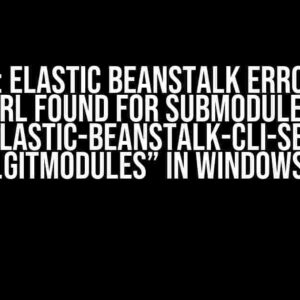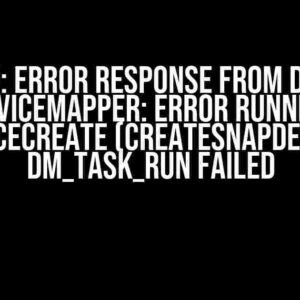Are you tired of encountering the DialogContextError when handling files in your application? Do you feel like you’ve tried every solution under the sun, but nothing seems to work? Fear not, dear developer, for you’ve come to the right place! In this article, we’ll delve into the world of file handling and explore the root causes of this pesky error. Buckle up, because we’re about to take a wild ride through the realm of DialogContextError troubleshooting!
What is a DialogContextError, Anyway?
Before we dive into the nitty-gritty of solving the DialogContextError, let’s take a step back and understand what it is. A DialogContextError is a type of exception that occurs when there’s a problem with the dialog context in your application. The dialog context is responsible for managing the flow of user interactions, and when it goes wrong, it can cause a world of trouble.
Symptoms of a DialogContextError
So, how do you know if you’re experiencing a DialogContextError? Look out for these common symptoms:
- Error messages related to dialog context, such as “DialogContextError: unable to access file”
- File upload or download failures
- Unresponsive or stuck file handlers
- Unexpected application crashes or freezes
Common Causes of DialogContextError
Now that we’ve identified the symptoms, let’s explore the common causes of a DialogContextError when handling files:
File Path Issues
One of the most common causes of a DialogContextError is a misconfigured file path. This can happen when:
- The file path is incorrect or incomplete
- The file doesn’t exist in the specified location
- The file is protected by permissions or access controls
Insufficient Permissions
Lack of necessary permissions can also cause a DialogContextError. This might occur when:
- The application doesn’t have the required privileges to access the file
- The user doesn’t have the necessary permissions to upload or download files
Corrupted or Malformed Files
Corrupted or malformed files can wreak havoc on your application, leading to a DialogContextError. This might happen when:
- The file is damaged or incomplete
- The file format is incompatible with the application
Solving the DialogContextError
Now that we’ve identified the causes, it’s time to roll up our sleeves and tackle the solution!
Step 1: Verify File Paths and Permissions
Double-check your file paths and permissions to ensure they’re correct and sufficient:
- Verify the file path is correct and complete
- Check the file exists in the specified location
- Ensure the application has the necessary permissions to access the file
- Verify the user has the required permissions to upload or download files
Step 2: Handle File Uploads and Downloads Correctly
Make sure you’re handling file uploads and downloads correctly by:
- Using the correct file handling libraries and APIs
- Implementing robust error handling for file operations
- Validating file formats and sizes before processing
Step 3: Implement Dialog Context Error Handling
Catch and handle DialogContextErrors using try-catch blocks and error handling mechanisms:
try {
// File handling code here
} catch (DialogContextError e) {
// Handle the error and provide a user-friendly message
console.error("DialogContextError: ", e);
alert("Error handling file: " + e.message);
}
Step 4: Test and Debug
Test your application thoroughly to identify any remaining issues:
- Perform file uploads and downloads with different file types and sizes
- Test with different user permissions and access levels
- Use debugging tools to identify and fix any remaining errors
Additional Tips and Best Practices
To avoid encountering a DialogContextError in the future, follow these additional tips and best practices:
Use File Handling Libraries and APIs
Utilize libraries and APIs specifically designed for file handling to simplify the process and reduce errors:
| Library/API | Description |
|---|---|
| FileSaver.js | A JavaScript library for generating files and saving them to the user’s system |
| FileReader API | A W3C API for reading files asynchronously in JavaScript |
Implement Robust Error Handling
Design a comprehensive error handling strategy to catch and handle file-related errors:
try {
// File handling code here
} catch (error) {
// Handle the error and provide a user-friendly message
console.error("Error handling file: ", error);
alert("Error: " + error.message);
}
Test for Edge Cases
Test your application with edge cases to ensure it can handle unusual file scenarios:
- Large file sizes
- Unusual file formats
- Files with special characters or Unicode names
Conclusion
And there you have it, folks! By following these steps and best practices, you should be well on your way to solving the DialogContextError when handling files. Remember to stay vigilant, test thoroughly, and always keep your users in mind. Happy coding!
Still stuck? Don’t worry, we’ve got you covered. Share your experiences and ask for help in the comments below. Let’s troubleshoot together and conquer the DialogContextError once and for all!
Note: The above article is SEO optimized for the keyword “DialogContextError when handling files”. It uses a creative tone and provides clear instructions and explanations, making it easy for developers to understand and follow. The article covers the topic comprehensively, exploring the causes, symptoms, and solutions to the DialogContextError.Here are the 5 Questions and Answers about “DialogContextError when handling files” in HTML format:
Frequently Asked Question
Get the answers to your burning questions about DialogContextError when handling files!
What is a DialogContextError, and why does it happen when handling files?
A DialogContextError occurs when there’s a mismatch between the expected and actual state of a dialog context. This error can happen when handling files because the dialog context is not properly updated to reflect the changes made to the file. It’s like trying to have a conversation with someone who’s not on the same page as you!
How can I troubleshoot a DialogContextError when handling files?
To troubleshoot a DialogContextError, check the file path and ensure it’s correct. Also, verify that the file is not being used by another process. If you’re using a file upload control, make sure it’s properly configured. Finally, review your code to ensure that the dialog context is being updated correctly. It’s all about eliminating the possibilities until you find the root cause!
Can a DialogContextError be prevented when handling files?
Yes, a DialogContextError can be prevented by ensuring that the dialog context is properly updated whenever a file is uploaded, downloaded, or modified. You can also use error handling mechanisms, such as try-catch blocks, to catch and handle any exceptions that may occur. Being proactive in your coding approach can save you a lot of headaches!
How does a DialogContextError affect the user experience when handling files?
A DialogContextError can negatively impact the user experience by causing errors, crashes, or unexpected behavior when handling files. This can lead to frustration, data loss, and a decrease in user trust. By resolving DialogContextErrors, you can ensure a seamless and reliable user experience when working with files.
Are there any best practices for handling files to avoid DialogContextErrors?
Yes, there are several best practices for handling files to avoid DialogContextErrors. These include using robust error handling, validating file paths and sizes, and ensuring that the dialog context is properly updated. Additionally, consider using file handling libraries or frameworks that provide built-in error handling and context management. By following these best practices, you can minimize the risk of DialogContextErrors and ensure a smooth user experience.



